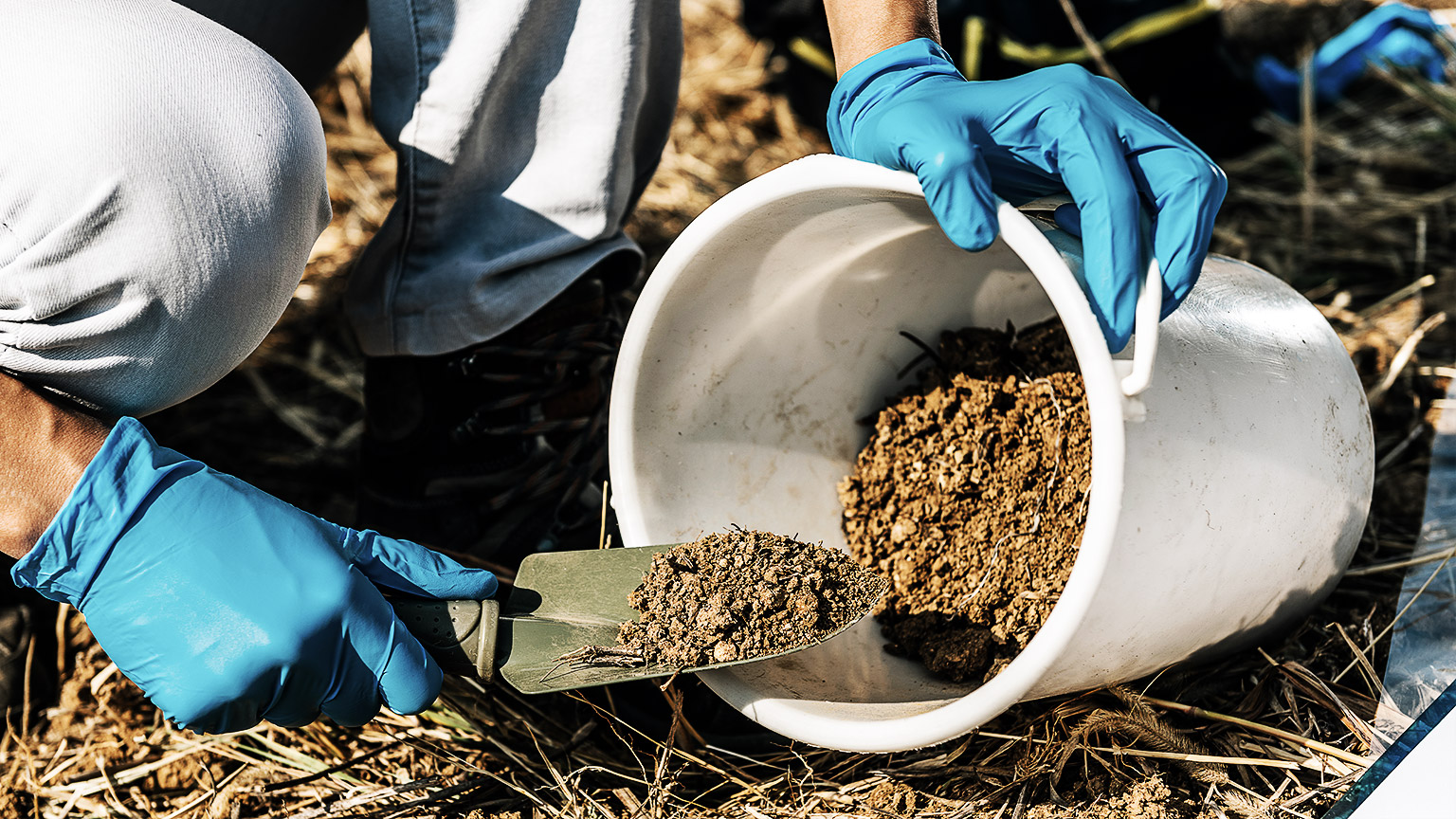In the previous topics we’ve been looking at what we can learn from our soil by observing, touching and smelling it, and what we can find out about it from online sources. We also looked briefly at how to test the pH of the soil in the field.
In this topic, we’ll talk about the types of laboratory (lab) tests you can get done on your soil and what these can tell us about your growing medium and what can be done to improve it.
Why test our soil?
That depends on what information you need from the soil.
For our purposes, we want to know: “Is my soil the best it can be for growing my crops?” In this topic, we'll look at a few key results that help us determine whether that is true or not.
However, that's not the only reason a grower may test their soil. Imagine someone that wants to become a certified organic grower. Can you think what they would test for? Take a moment and think about it.
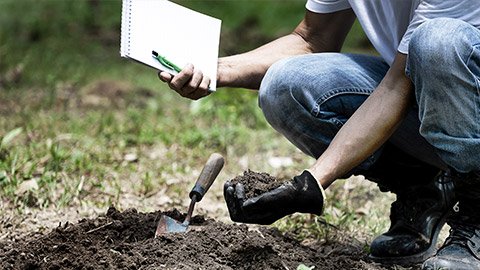
Did you think someone that wants to grow organically would need to know: “Are there any pesticide residues or heavy metals in my soil?”
Hill Laboratories is a testing lab that performs soil testing, among other things. The test results we’ll use in this topic were provided by Hill Laboratories based on soil sampled from a site in the Manawatū.
If you want to get a soil test processed by Hill Labs, you can go to their website and order a free DIY Sampling Kit. For a home or community garden, choose the Lifestyle Block Agriculture Sampling Kit. The kit is free, but there is a service charge for the soil testing.

When the sampling kit arrives, it will contain instructions about the types of tests, and how to take a soil sample.
It will also include a test request form, soil and plant sample bags, and a courier bag to post the samples.
The test request form asks you to indicate which soil tests you’d like the lab to carry out. For home and community gardens, the following soil tests may offer useful insight and are the ones we opted for.
| Basic soil test (BS) | Includes pH, availability of five major nutrients, CEC, and other tests, which offer a general sense of the nutrient status of the soil. |
| Sulphur profile (S) | Indicates extractable organic sulphur which is important for plant growth and development. Sulphur is a component of several important plant compounds, including amino acids, vitamins, and enzymes. It also helps plants resist various stresses, such as drought, temperature extremes, and pests. |
| Organic soil profile (OrgSP) | Includes carbon, nitrogen and organic matter. Soil carbon is the most important influence on soil quality, as it has a role in all soil functions. |
The kit contains information about how to take samples.
You'll need to follow the instructions that come with the kit, but here are some handy tips for you:
- Sample from the area you are, or plan to, grow plants in.
- Use a small trowel to get the soil out of the ground and place it in one of the soil sample bags provided.
- If you’re growing vegetables, sample to a depth of 150mm.
- Take 5-20 small samples from the same area and place these in the bag. You don’t need much from each location - all in all. The minimum combined weight of the sample cores is 500 grams (at the time of writing).
- Use a small trowel to get the soil out of the ground and place it in one of the soil sample bags provided.
- Fill out the test request form (Analysis Request) making sure to tick the boxes of the types of tests you want the lab to perform.
- Place the bag of sampled soil and the Analysis Request into the courier bag and drop it off at your nearest Post Shop or Courier Post depot.
![[ADD IMAGE'S ALT TEXT]](/sites/default/files/Hill%20Laboratories.png)
When your soil sample has been processed, you’ll receive an email with the results and an invoice for the analysis.
For the three types of tests we requested, the total cost was about NZ$135, in March 2023.
We'll help you interpret the soil test results and guide you on the actions those results suggest to do to augment the soil for your specific growing purposes.
Your test results will be provided in a PDF report. Page one is shown here:

The first page contains the results, as averages, and the recommended ranges of each of these properties. If you provided multiple sample bags, e.g., a bag called Sample 01 from your front garden and another bag called Sample 02 from your back garden, the values from each sample will be provided on page two.
The pages after that provide a description of each of the tests used.
If it doesn't open automatically, go ahead and open it in a new tab or in the Adobe Viewer and refer to it as we work through this subtopic.
The first page of the test result is generally set out in the order of the tests requested. The graphic below indicates how the rows align with the three tests we ordered.
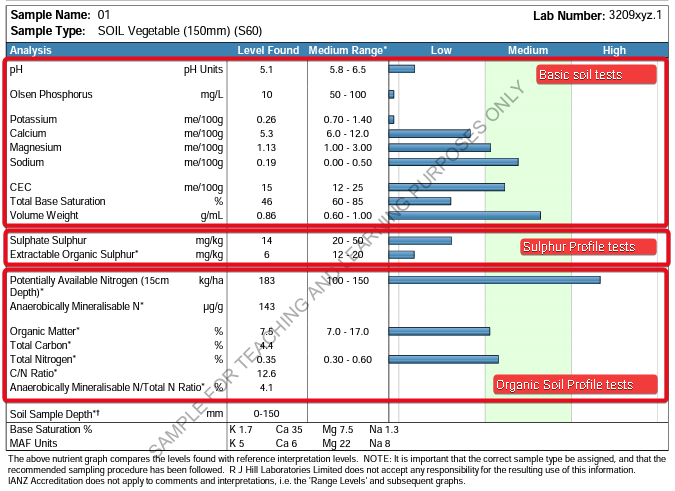
In this module, we’ve grouped the test results together based on their type rather than the testing profiles they sit under.
Let’s take a closer look at the first page. The main analysis table is divided into four sections:
| Column heading | Interpretation |
|---|---|
| Analysis | Lists the characteristics that are being tested, e.g., the pH level. |
| Level Found | Gives the value reported by the test, e.g., for pH the value found was 5.1. |
| Medium Range* | Gives the upper and lower limit of the medium band for that value. For example, the medium range for soil pH is 5.8 - 6.5. |
| Low | Medium | High |
This three-part section is a histogram-style graph that shows the results visually. It is divided into Low, Medium (green-shaded) and High ranges.
|
Let’s investigate the findings from a few of the most important results.
Soil pH
As mentioned earlier, pH refers to the potential of hydrogen present. This is a measure of how acidic or alkaline our soil is. Vegetables prefer a slightly acid to neutral pH of 6 to 7.
It should be noted that the pH scale is logarithmic, so a pH of 6 is ten times more acidic than a pH of 7. A soil with a pH of 5 is 100 times more acidic than a soil with a pH of 7! At 5.1, we can see our soil pH is much lower than the medium range. As shown earlier, at low pH, some nutrients are difficult for plants to access, such as nitrogen, potassium and sulphur.
Additionally, according to Hill Laboratories, below 5.5, bacterial nitrogen fixation is significantly reduced.
Looking at the results, and using the information above, can you make a determination about the acidity level in our sample soil? Take a guess and then click (+) to reveal the answer.
Our soil is too acidic for most crops we’d choose to grow.
- The pH level on our tests: 5.1
- The pH level indicated as medium range is: 5.8 - 6.5
- 5.1 is less than 5.8-6.5, so our pH is LOW, which means the soil is acidic.
Soil macronutrients
For ideal growth, plants need access to six nutrients that they take up in large quantities. These are referred to as macronutrients. They also need access to a handful of other nutrients in smaller quantities, which are called micronutrients, or trace elements.
The macronutrients that plants need in order of most to least are:
| Macronutrient | What it brings to the plant |
|---|---|
| Nitrogen (N) Nitrogen is a component of many important biological molecules that are essential for plant growth, development, and reproduction. |
|
| Phosphorus (P) Phosphorus is another essential nutrient for plants, as it is a critical component of several important biological molecules that are essential for plant growth, development, and reproduction. |
|
| Potassium (K) |
|
| Calcium (Ca) |
|
| Magnesium (Mg) |
|
| Sulphur (S) |
|
Good news: The test results from the lab show how much of each of the macronutrients are present in the soil.
It must be noted that test results show the concentration of these macronutrients in the sampled soil. Where plant roots grow deeper than the sampling depth – e.g., fruit trees – they may well be able to access nutrients deeper in the profile. In these cases, the test results may underestimate available nutrients.
Nitrogen (N)
(Manaaki Whenua Landcare Research)A large amount of nitrogen in soil is in the form of organic matter. Before plants are able to make use of this nitrogen it needs to be mineralised by soil microbes into ammonium and nitrate. Only a small proportion of the total nitrogen is able to be mineralised within a growing season.
The anaerobically mineralisable nitrogen test measures how much nitrogen from organic matter can be mineralised to inorganic nitrogen (nitrogen that is available to the plant).
Our soil tested 143 μg/g (micrograms per gram) of anaerobically mineralisable nitrogen. This raw value is converted into potentially available nitrogen estimated in kilograms per hectare (kg/ha). The graph for potentially available nitrogen shows that the soil contains enough nitrogen available to plants.
Additionally, anaerobically mineralisable nitrogen (and therefore potentially available nitrogen) is a good indicator of biological activity and is closely related to microbial biomass.
Now that you have read about the accessibility of nitrogen to our plants, and the level of biological activity in our soil. Think about whether you will need to improve the soil for those plant benefits, or if the test results indicate they are adequate for our needs. Then click the (+) to check your answer.
Our soil looks good in terms of both:
- Nitrogen that is accessible by our plants
- This can be assessed by noting the high level of potentially available nitrogen.
- Biological activity
- This can be assessed because the level of anaerobically mineralisable nitrogen (as represented as potentially available nitrogen) can be considered a good indicator of biological activity.
Phosphorous (P)
Soil test extraction procedures try to extract the same proportion of phosphorous from the soil as plants do. It would be impossible to design a universal soil test to measure the available P in a soil because different plant species growing in the same soil, and similar plants growing in different soils are too different for a single test.
That said, the Olsen Phosphorous (P) test is the standard method in New Zealand to assess phosphorus availability to plants. It provides a good estimate of the availability of P in Aotearoa soils for a wide range of crops.
Take a look at our report, what is the Olsen P, and what does that indicate? Come up with your answer before clicking the (+) to see if you got it right.
Our soil is extremely low in phosphorous.
- The Olsen Phosphorous of our soil is 10mg/L.
- The medium range is 50-100mg/L.
Cation nutrients (K, Ca, Mg, Na)
Potassium (K), calcium (Ca), magnesium (Mg), and sodium (Na), are referred to as the cation nutrients because they are positively (+) charged ions in the soil solution. These nutrients are important for plant and/or animal growth and production and influence soil physical structure.
Potassium, calcium, and magnesium are macronutrients. These are expressed in units of milliequivalents per 100 grams of soil (me/100g).
Look at the results in our soil for potassium, calcium and magensium. Do we have enough of each for healthy soil? When you have your answer, select the (+) below to check it.
Our soil:
- is extremely low in potassium
- The level of potassium found was 0.26me/100g
- The medium range is 0.70-1.40me/100g
- is low in calcium
- The level of calcium found was 5.3me/100g
- The medium range is 6.0-12.0me/100g
- has an adequate amount of magnesium
- The level of magnesium found was 1.13me/100g
- The medium range is 1.00 - 3.00me/100g.
CEC and base saturation
As mentioned earlier, cation exchange capacity (CEC) is a measure of the soil's ability to hold and exchange positively charged ions (cations).
The CEC is expressed in units of milliequivalents per 100 grams of soil (me/100g) and reflects the amount of cations that can be adsorbed by the soil (sit on the outside of soil particles).
Our soil has a CEC of 15, which is in the medium range. This tells us that the soil is able to hold a reasonable amount of cation nutrients which will be available to the plants.
The proportion of the soil’s total capacity for cations that is actually occupied by these nutrients is referred to as the total base saturation. In our case, the total base saturation is 46%, which means that 46% of the total sites where cations could sit, are occupied by cations, which is in the low range. The medium range for this is 60-85%.
Base saturation is closely related to soil pH. As the pH of the soil increases (becomes more alkaline) the base saturation increases. Remember that our soil is very acidic, which is likely to be a key reason its base saturation is low.
Another reason could be the low levels of cation nutrients, such as potassium and calcium, meaning there aren’t enough cation nutrients to fill the exchange sites.
Take a few moments and jot down the answers to these questions about our soil test results:
- Does our soil have a reasonable potential to exchange cation nutrients with our plants?
- Does our soil have a reasonable portion of cation exchange sites occupied by cation nutrients? If not, why not?
When you are ready click the (+) to see if you got the answers right.
Our soil:
- Has a reasonable potential to exchange cation nutrients with our plants
- The CEC is 15me/100gm
- The medium range for CEC is 12-25
- Has a low proportion of cation exchange sites occupied by cation nutrients, which:
- is likely due to low pH
- may be made worse by lower than ideal levels of K and Ca.
Sulphur (S)
Sulfate-sulphur is readily available to plants. By contrast, most soil sulphur is in organic form and is not available to plants. However, over time, small amounts of organic sulphur are converted to a form that is plant available.
Take a look at the results about the sulphur in our soil. Can you make some determinations about available sulphur and organic sulphur?
Our soil:
- Has a low level of immediately available sulphur (sulfate sulphur)
- The sulphate-sulphur is 14mg/kg
- The medium range is 20-50.
- Has a low level of organic sulphur that is being made plant available.
- The extractable organic sulphur is 6mg/kg
- The medium range is 12-20.
Volume weight
Is a measure of the density of the soil once it has been prepared in the lab. The volume weight gives an indication of the physical properties of the soil (texture, structure, porosity, drainage, etc.) and is used to calculate other values.
It doesn’t have much bearing on how we manage our soil.
Organic matter
Hill Laboratories says:
The Organic Matter (OM) level in the soil is strongly correlated to the soil’s CEC, and is a source of many plant nutrients, particularly nitrogen.
Organic matter also plays a major role in determining soil physical characteristics; soils with medium to high OM levels would generally be expected to have good structure, moisture retention and water infiltration.
After reviewing our results, what do you know about the organic matter content in our soil sample? Determine the answer and then click the (+) to check it.
Our soil:
The OM content of our soil is at the low end of the medium range.
- Our soil has an adequate amount of organic matter.
- The organic matter makes up 7.5% of our sample soil
- The medium range is 7.0-17.0%.
An excellent general resource from Hill Laboratories for this topic is: Technical Note: Soil Tests and Interpretation
Activity – Testing your soil quiz
Take this seven-question quiz to confirm your knowledge of soil testing. Good luck!
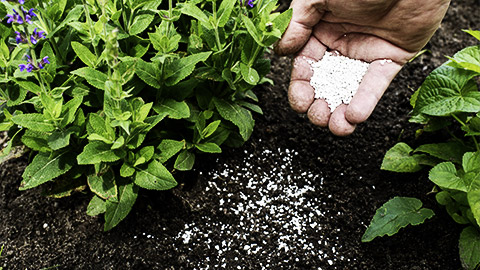
This soil is being amended with lime to help raise the pH and provide more nutrients to the plants.
Our soil: A case study
We'll use our soil sample as a case study so you can see the choices we would make to augment our soil.
Let's recap. Based on the results, our soil:
- ❌ is too acidic
- ✔️ has enough plant-accessible nitrogen
- ✔️ has a good level of biological activity
- ❌ is extremely low in phosphorous
- ❌ is extremely low in potassium
- ❌ is low in calcium
- ✔️ has an adequate amount of magnesium
- ✔️ has a reasonable potential to exchange cation nutrients with our plants
- ❌ has a low proportion of cation exchange sites occupied by cation nutrients
- ❌ has a low level of immediately available sulphur (sulfate sulphur)
- ❌ has a low level of organic sulphur that is being made plant available
- ✔️ has an adequate amount of organic matter.
Now that we know what our soil is lacking, we can treat specific issues.
Add lime
We can increase the pH by adding lime. This will help in several ways:
- Increasing the pH will make more nutrients plant available by increasing the base saturation.
- Garden lime is high in calcium (Ca), which is low in our soil.
- Lime can also encourage biological activity which in turn can help break up clay soils.
How much lime to use
| How much lime to add | Impact | |
|---|---|---|
| General | 20kg per 100m2 (or 200g/m2) | 1 pH point |
| Our soil example |
|
|
It can take from a few weeks to a few months for the pH of the soil to adjust, so we’ll test the soil pH monthly using a field soil pH test kit and add more lime if required.
An alternative is to add dolomite lime which contains magnesium (Mg), but it is generally slower to act on soil pH. Given the acidity of the soil is very high (the pH is low), decreasing the acidity is the main goal, so using lime will be better in the first instance.
Add organic matter
While the soil’s organic matter is in the medium range, it is at the bottom of that range. That means there is potential for us to add more organic matter in the form of compost, manure, or a mix of the two. This will help in several ways:
- Improve soil fertility through the addition of nitrogen, phosphorous, and potassium.
- Improve the CEC of the soil, meaning that cations such as potassium and calcium will be available to the plants in greater quantities.
- Improve soil structure which will in turn encourage greater biological activity
How much organic matter to use
Organic matter varies based on what it is, so a general rule isn't entirely possible. But usually it's spread evenly over the soil.
Because most compost is acidic, we may be better off adding worm castings as they have a neutral pH. Applying a thin layer – say 25-30mm – should be enough.
Add gypsum
Gypsum (calcium sulfate) could also be added in order to:
- Help break up the clay soil.
- Add sulphate sulphur to the soil.
It may be more appropriate to add this in a few months’ time, once the soil pH has reached the desired level, at which point the addition of sulphate sulphur will have a more favourable impact on the plants.
General guidance
Whichever company you use to process soil tests, they should be able to provide general information about what each test measures and how it is performed.
Some will provide additional information about how to interpret the soil results and may offer guidance about what action to take in response to your results, though not all will.
The Technical Notes provided by Hill Laboratories offer some useful information, though they can be a bit science-y so you might need to read them a few times over.
Handy tips: Basic guidelines for treating soil
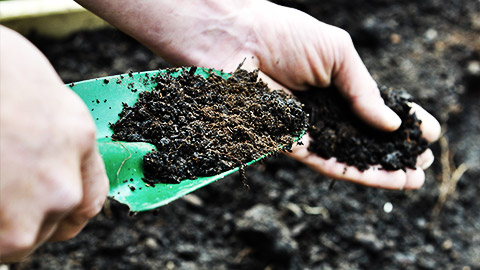
- Work on soil pH first. It may not be possible to get it to the desired pH in one go but make a start at least.
- After that, focus on remedying other characteristics that are deficient.
- It’s better to add small amounts of nutrients or amendments regularly than to put a lot down at once as this can disturb the biology of the soil.
- If in doubt, add organic matter. Unless you’re growing in highly organic (spongy) soils, you shouldn’t need to worry about having too much organic matter.
- If still in doubt, ask an experienced gardener or horticulturalist.
